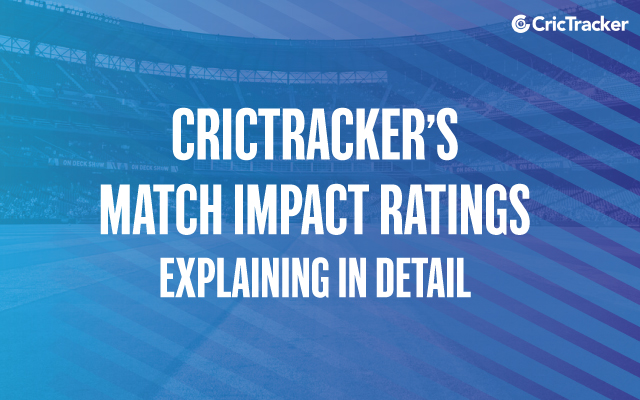CricTracker's Match Impact Ratings for IPL 2020- Explaining in Detail
All questions answered for our Match Impact Ratings article.
4 Min Read

![]()
CricTracker has come up with a unique article for the Indian Premier League (IPL) 2020 rating the players every match on the basis of their impact in that particular game. An algorithm is built to evaluate the performance of every cricketer involved in the match with the bat and ball. It might find surprising for many at times that a player who has won the Man of the Match might not be the one with highest rating in the match impact.
Here’s the detailed explanation of how match impact rating is decided:
How is match impact rating calculated?
The algorithm built for the Match Impact rating analyses each and every ball in the match and then the rating is measured for all the players. Rating can be positive or negative according to the performances of the 22 cricketers for their respective teams.
Who will have advantage?
Strike-rate for batsmen and economy rate for bowlers play a higher role in accessing the impact of a player. If a player bats through the innings playing the role of an anchor at a strike-rate of around 130 and scored 50 runs, then his impact score will be less compared to the one who scored runs at a better strike-rate.
Example: In the first match between MI and CSK, Faf du Plessis scored 58 off 44 balls at a strike-rate of 131.82. At the Sam Curran scored a quick-fire 18 runs at a strike-rate of 300. So, going by the strike-rate of two players, Curran’s batting impact score was 14 while Du Plessis’ score was only 1.2.
It applies even for the bowlers as a player who has picked up a wicket but is expensive might have lesser impact than a player who hasn’t picked up a wicket but has been extremely economical.
Example: In the third match between SRH and RCB, Vijay Shankar bowled 1.2 overs and conceded 14 runs picking up a wicket. His economy was of 10.5. At the same time, his teammate Bhuvneshwar Kumar didn’t pick up a wicket but went for only 25 runs in four overs. His economy rate read 6.2. For being economical, Bhuvi got a bowling impact score of 1.51 while Shankar got only 0.06.
Impact ratings change according to type of game:
1. Low-scoring games
In case both the teams score around 150 runs in the game, batsmen mustering runs at around 150 strike-rate will have higher impact. At the same time, the bowlers will have to be economical in such matches and concede at an economy less than 7 to have a positive impact score. If they consider more than 7 runs per over, their impact will be less or it might go into negative as well given that the match was a low-scoring affair.
Example: The match 2 between DC and KXIP was the one where both teams scored in the range of 150s. Mayank Agarwal scored 89 off 60 deliveries at a strike-rate of 148.33 and got a positive impact rating of 20.46. If he had scored those runs in a high-scoring game, then his impact score would’ve been less or in negative (explained later).
Among the bowlers, Krishnappa Gowtham conceded 39 run in his four overs and ended up with an impact score of -2.08. Economy of almost 10 is very much high in an innings where 157 runs were scored. However, if he had conceded 39 runs in an inning where 200 runs were scored, his impact rating would’ve been positive (explained later).
2. High-scoring games
In case, the two teams involved in the game score more than 200 runs each, then a strike-rate of 150 might not be good enough for the batsmen to gain a positive impact score. They will have to score runs at better SR. Here there is a leeway for the bowlers as they can have a positive impact score even after conceding runs at an economy of 8 or 9.
Example: In match 4 between CSK and RR, Sanju Samson scored 74 off 32 balls at an SR of 231.25 and obviously, he got an impact score of 26.06. The RR skipper Steve Smith also scored 69 runs, only five less than Samson, but he ended up with a negative impact score due to his strike-rate of 146.81.
In case of bowlers, the likes of Rahul Tewatia (3/37) and Shreyas Gopal (1/38) had economy rate of almost 10. But still their impact scores read, 11.45 and 4.30 respectively thanks to the wickets they picked. Rather even Ravindra Jadeja got a positive impact score of 0.35 with the ball despite going for 40 runs in his four overs. If he had picked up a wicket or two, his impact would’ve been more.
Download Our App